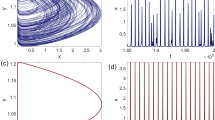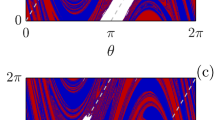Abstract
A largely phenomenological study of two-dimensional cellular automata is reported. Qualitative classes of behavior similar to those in one-dimensional cellular automata are found. Growth from simple seeds in two-dimensiona! cellular automata can produce patterns with complicated boundaries, characterized by a variety of growth dimensions. Evolution from disordered states can give domains with boundaries that execute effectively continuous motions. Some global properties of cellular automata can be described by entropies and Lyapunov exponents. Others are undecidable.
Similar content being viewed by others
References
S. Wolfram, Cellular automata as models for complexity,Nature 311:419 (1984).
T. Toffoli, Cellular automata mechanics, Ph.D. thesis and Technical Report 208, The Logic of Computers Group, University of Michigan (1977).
G. Vichniac, Simulating physics with cellular automata,Physica 10D:96 (1984).
S. Wolfram, Statistical mechanics of cellular automata,Rev. Mod. Phys. 55:601 (1983).
O. Martin, A. Odlyzko, and S. Wolfram, Algebraic properties of cellular automata,Commun. Math. Phys. 93:219 (1984).
N. Packard, Cellular automaton models for dendritic crystal growth, Institute for Advanced Study, preprint (1985).
S. Wolfram, Universality and complexity in cellular automata,Physica 10D:1 (1984).
E. R. Berlekamp, J. H. Conway, and R. K. Guy,Winning Ways for Your Mathematical Plays, Vol. 2 (Academic Press, New York, 1982), Chap. 25; M. Gardner,Wheels, Life and Other Mathematical Amusements (Freeman, San Francisco, 1983).
T. Toffoli, CAM: A high-performance cellular-automaton machine,Physica 10D:195 (1984).
J. Guckenheimer and P. Holmes,Nonlinear Oscillations, Dynamical Systems, and Bifurcations of Vector Fields (Springer, New York, 1983).
J. E. Hopcroft and J. D. Ullman,Introduction to Automata Theory, Languages, and Computation (Addison-Wesley, Reading, Massachusetts, 1979).
S. Wolfram, Computation theory of cellular automata,Commun. Math. Phys. 96:15 (1984).
L. Hurd, Formal language characterizations of cellular automaton limit sets, to be published.
S. Willson, On convergence of configurations,Discrete Math. 23:279 (1978).
T. Yaku, The constructability of a configuration in a cellular automaton,J. Comput. Syst. Sci. 7:481 (1973); U. Golze, Differences between 1- and 2-dimensional cell spaces, inAutomata, Languages, Development, A. Lindenmayer and G. Rozenberg, eds. (North-Holland, Amsterdam, 1976).
J. Hardy, O. de Pazzis, and Y. Pomeau, Molecular dynamics of a classical lattice gas: transport properties and time correlation functions,Phys. Rev. A13:1949 (1976).
S. Wolfram, Cellular automata,Los Alamos Science (Fall 1983); Some recent results and questions about cellular automata, Institute for Advanced Study preprint (September 1983).
S. Wolfram, Twenty problems in the theory of cellular automata,Phys. Scripta (to be published).
S. Wolfram, Computer software in science and mathematics,Sci. Am. 251(3):188 (1984).
S. Willson, Comparing limit sets for certain increasing cellular automata, Mathematics Department, Iowa State University preprint (June 1984).
S. Willson, Growth rates and fractional dimensions in cellular automata,Physica 10D:69 (1984).
N. Packard, Notes on a Go-playing program, unpublished (1984).
Y. Sawada, M. Matsushita, M. Yamazaki, and H. Kondo, Morphological phase transition measured by “surface kinetic dimension” of growing random patterns,Phys. Scripta (to be published).
J. M. Greenberg, B. D. Hassard, and S. P. Hastings, Pattern formation and periodic structures in systems modelled by reaction-diffusion equations,Bull. Am. Math. Soc. 84:1296 (1975); B. Madore and W. Freedman, Computer simulations of the Belousov-Zhabotinsky reaction,Science 222:615 (1983).
K. Prestonet al., Basics of cellular logic with some applications in medical image processing,Proc. IEEE 67:826 (1979).
J. W. Essam, Percolation theory,Rep. Prog. Phys. 43:833 (1980).
P. Grassberger, Chaos and diffusion in deterministic cellular automata,Physica 10D:52 (1984).
G. Vichniac, Cellular automaton dynamics for interface motion and ordering, M.I.T. report, to appear.
R. Rosensweig, Fluid dynamics and science of magnetic liquids,Adv. Electronics Electron Phys. 48:103 (1979); Magnetic fluids,Sci. Am. 247(4):136 (1982).
G. A. Hedlund, Endomorphisms and automorphisms of the shift dynamical system,Math. Syst. Theory 3:320 (1969); G. A. Hedlund, Transformations commuting with the shift, inTopological Dynamics, J. Auslander and W. H. Gottschalk, eds. (Benjamin, New York, 1968); S. Amoroso and Y. N. Patt, Decision procedures for surjectivity and injectivity of parallel maps for tessellation structures,J. Comp. Syst. Sci. 6:448 (1972); M. Nasu, Local maps inducing surjective global maps of one-dimensional tessellation automata,Math. Syst. Theory 11:327 (1978).
H. Wang, Proving theorems by pattern recognition-II,Bell. Syst. Tech. J. 40:1 (1961).
R. Berger, The undecidability of the domino problem,Mem. Am. Math. Soc., No.66 (1966).
R. Robinson, Undecidability and nonperiodicity for tilings of the plane,Inventiones Math. 12:177 (1971).
D. Ruelle,Thermodynamic Formalism (Addison-Wesley, Reading, Massachusetts, 1978), p. 68.
R. Penrose, Pentaplexity: a class of nonperiodic tilings of the plane,Math. Intelligencer 2:32 (1979); M. Gardner, Extraordinary nonperiodic tiling that enriches the theory of tiles,Sci. Am. 236(1):110 (1977); N. de Bruijn, Algebraic theory of Penrose's nonperiodic tilings of the plane,Nederl. Akad. Wetensch. Indag. Math. 43:39 (1981).
P. Kramer, Non-periodic central space filling with icosahedral symmetry using copies of seven elementary cells,Acta Crystallogr. A38:257 (1982).
M. Garey and D. Johnson,Computers and Intractability: A Guide to the Theory of NP-completeness (Freeman, San Francisco, 1979), p. 257.
J. Milnor, Entropy of cellular automaton-maps, Institute for Advanced Study preprint (May 1984).
J. Milnor, Directional entropies in higher dimensions, rough notes (September 1984).
N. Packard, Complexity of growing patterns in cellular automata, Institute for Advanced Study preprint (October 1983).
J. Milnor, Notes on surjective cellular automaton-maps, Institute for Advanced Study preprint (June 1984).
N. D. Mermin, The topological theory of defects in ordered media,Rev. Mod. Phys. 51:591 (1979).
A. Winfree and E. Winfree, Organizing centers in a cellular excitable medium, Purdue University preprint (July 1984) andPhysica D (to be published).
Author information
Authors and Affiliations
Additional information
This work was supported in part by the U.S. Office of Naval Research under Contract No. N00014-80-C-0657.
Rights and permissions
About this article
Cite this article
Packard, N.H., Wolfram, S. Two-dimensional cellular automata. J Stat Phys 38, 901–946 (1985). https://doi.org/10.1007/BF01010423
Received:
Issue Date:
DOI: https://doi.org/10.1007/BF01010423




